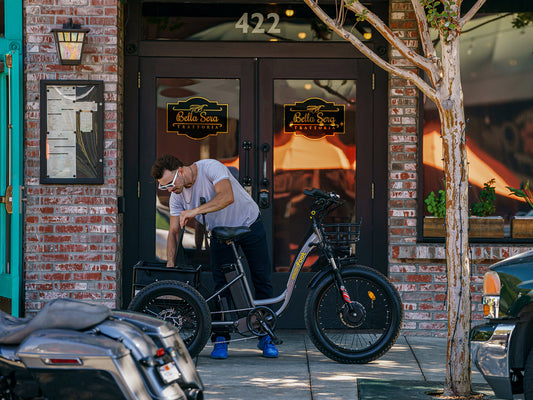Electric trikes present an ideal option for seniors, adults, or anyone with mobility issues. They offer increased stability and control for an enjoyable biking adventure. Among various e-trike models, rear drive electric trikes are rapidly gaining prominence.
In this article, we will understand the construction of a rear hub trike and get into the reasons why switching to rear hub drive e-trikes could enhance your biking experience.
Construction of a Rear Hub Drive Trike
As in the name, an electric trike has three wheels, two behind and one ahead – that’s the common construction. The motor is placed on the rear hub on the axle between the two wheels.
When you push the throttle, the motor turns on and powers the rear wheels. The two rotating wheels force the front wheel and push it forward. It’s similar to a rear-wheel drive (RWD) car or a motorbike construction, where the rear wheel receives power and propels the bike.
The motor also placement affects the trike's weight distribution. This rear-centric weight distribution aids in better traction, especially when climbing hills or traversing uneven surfaces. It also prevents the front end of the trike from becoming too heavy, making handling easier.
Why Shift Towards Rear Hub Drive Trikes?
The position of the motor at the back end makes a significant difference in the ride and bike’s capabilities. Here’s how it benefits you and why you should switch to it.
1. The Push-Pull DIfference
In trikes where the electric motor is placed on the front, that’s called the front hub trike. In that case, the motor powers the front wheel and it has to ‘pull’ the other two wheels. Imagine it as pulling a cart from the front.
Conversely, in rear drive electric trikes, the motor is in the rear wheel, and it 'pushes' the trike forward. This push mechanism provides a more natural feeling of acceleration and movement.
This push-pull difference can be imagined with a situation. You have to take a cart to the hill-top crossing the inclined path. Which method would be easier, pushing it from behind or pulling it from the front?
Pushing would be better, right? That’s why the rear trikes excel when you have to ascend a hill, as it’s easier to push one wheel with a rotating power of two wheels.
2. Prevention of Front-Tire Slippage
Trikes with front hub motors often experience front tire slippage since the motor's torque impacts the front wheel directly. This issue becomes evident in wet or loose conditions, where applying power can lead to the front wheel losing grip, resulting in control challenges. The problem intensifies during hill climbs or rapid accelerations, as the front wheel is prone to spinning ineffectively.
In contrast, rear hub drive trikes, with power distributed to the rear wheels, maintain a more stable grip due to the combined weight and power at the back. This design ensures stability even during acceleration.
3. Enhanced Control
The motor and main weight being positioned at the rear not only stabilize the trike but also free up the front wheel. This absence of load and motor on the front wheel facilitates easier and more precise steering. You can make turns with greater ease, and the trike responds more accurately to steering inputs.
Furthermore, the balanced weight distribution inherent in the rear hub design contributes to more stable handling overall.
4. Front-Fork Flexibility
With the front hub free from the additional weight and complexity of a motor, derailleur, and other attachments, there’s greater scope for incorporating flexible front travel suspension systems.
You don’t have to necessarily make the front fork rigid. You can place a front-travel suspension system, which is more responsive and adaptive to varying road conditions. It means a simple trike could turn into an off-road trike.
5. Efficient Power Use
Instead of powering the front, the more optimal and feasible option is dividing the battery power among the rear wheels. This rear hub construction makes that possible. As per an estimate, it improves motor performance by 40%.
The backward push is not only simpler but also a more efficient way of distributing power. It results in a smoother and more natural riding experience, especially noticeable when pedal assistance is engaged early on.
With less power required for propulsion, there's a significant saving in battery usage. This efficiency translates into longer battery life and extended range. That means, your assistance range also increases.
Final Words
You have seen the compelling advantages of switching to rear hub trikes. They offer enhanced stability, quicker acceleration, and, most importantly, improved control on even terrain.
Looking for such a trike? Maxfoot has recently upgraded its hot-selling model, the MF-30, to a rear hub trike. This new version comes with a UL-certified battery, providing both enhanced power and more thrill. Get your MF-30 now and experience the difference.




